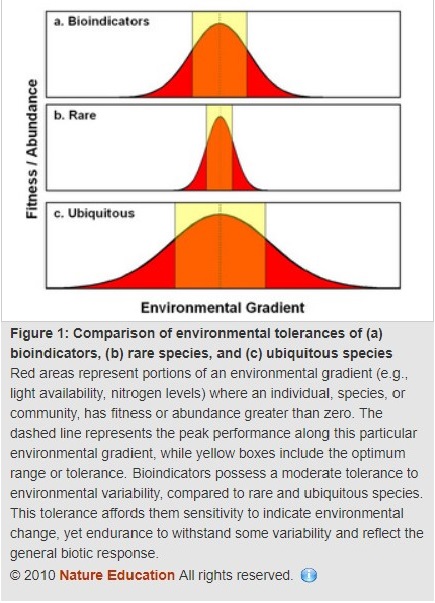3.1. Bioindicators
All species tolerate a limited range of chemical, physical, and biological conditions, which we can use to evaluate environmental quality. Despite many technological advances, we find ourselves turning to the biota of natural ecosystems to tell us the story of our world. Bioindicators include biological processes, species, or communities and are used to assess the quality of the environment and how it changes over time. Changes in the environment are often attributed to anthropogenic disturbances (e.g., pollution, land use changes) or natural stressors (e.g., drought, late spring freeze), although anthropogenic stressors form the primary focus of bioindicator research. The widespread development and application of bioindicators has occurred primarily since the 1960s. Over the years, we have expanded our repertoire of bioindicators to assist us in studying all types of environments (i.e., aquatic and terrestrial), using all major taxonomic groups.
Scientists have traditionally conducted chemical assays and directly measured physical parameters of the environment (e.g., ambient temperature, salinity, nutrients, pollutants, available light and gas levels), whereas the use of bioindicators uses the biota to assess the cumulative impacts of both chemical pollutants and habitat alterations over time. Consequently, the use of bioindicators is different from classic measures of environmental quality and offers numerous advantages. First, bioindicators add a temporal component corresponding to the life span or residence time of an organism in a particular system, allowing the integration of current, past, or future environmental conditions. In contrast, many chemical and physical measurements only characterize conditions at the time of sampling. Another benefit of the use of bioindicators is their ability to indicate indirect biotic effects of pollutants when many physical or chemical measurements cannot. Indirect contaminant effects are especially difficult to glean from chemical or physical measurements in the case of bioaccumulation. Metals, among other contaminants, accumulate in biological organisms, causing metal concentrations to amplify through food webs. Thus, contaminant levels at higher trophic levels may be underrepresented by physical or chemical measurements.
Yet bioindicators are not without their problems. In some instances, we cannot discriminate natural variability from changes due to human impacts, thus limiting the applicability of bioindicators in heterogeneous environments. Accordingly, populations of indicator species may be influenced by factors other than the disturbance or stress (e.g., disease, parasitism, competition, predation). A second criticism of the use of bioindicators is that their indicator ability is scale-dependent. For example, a large vertebrate indicator (e.g., a fish) may fail to indicate the biodiversity of the local insect community. Third, bioindicator species invariably have differing habitat requirements than other species in their ecosystem. Managing an ecosystem according to the habitat requirements of a particular bioindicator may fail to protect rare species with different requirements. However, the limitations of bioindicators are clearly overshadowed by their benefits.
Bioindicator species effectively indicate the condition of the environment because of their moderate tolerance to environmental variability, compared to rare and ubiquitous species (Figure 3.1.1.).

This tolerance affords them sensitivity to indicate environmental change, yet endurance to withstand some variability and reflect the general biotic response. The use of bioindicators, however, is not just restricted to a single species with a limited environmental tolerance. Entire communities, encompassing a broad range of environmental tolerances, can serve as bioindicators and represent multiple sources of data to assess environmental condition. Pollution and other stress agents can be monitored by measuring any of several variables in animals: the concentration of toxins in animal tissues; the rate at which deformities arise in animal populations; behaviour in the field or in the laboratory; and by assessing changes in individual physiology. Lastly, given the thousands of substances and factors to monitor, scientists now understand that the biota itself is the best predictor of how ecosystems respond to disturbance or the presence of a stressor.
No single species can adequately indicate every type of disturbance or stress in all environments. Depending upon the specific environment, the species present, and local disturbances, appropriate bioindicator species or groups of species need to be selected. Ecologists have established a broad set of criteria that species must exhibit to be considered good bioindicators (see Table 1).


